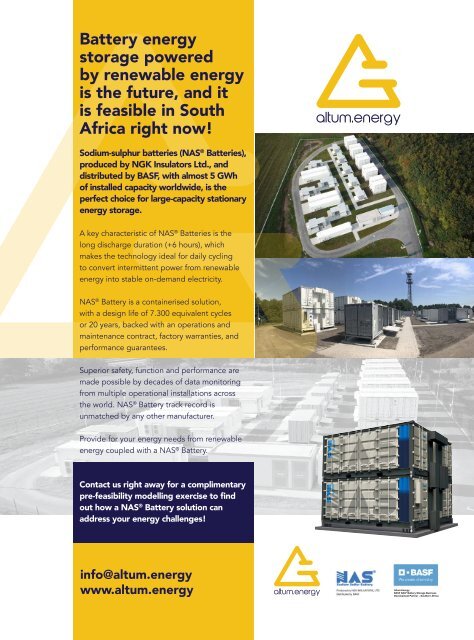Green Economy Journal Issue 58
You also want an ePaper? Increase the reach of your titles
YUMPU automatically turns print PDFs into web optimized ePapers that Google loves.
Battery energy<br />
storage powered<br />
by renewable energy<br />
is the future, and it<br />
is feasible in South<br />
Africa right now!<br />
Sodium-sulphur batteries (NAS ® Batteries),<br />
produced by NGK Insulators Ltd., and<br />
distributed by BASF, with almost 5 GWh<br />
of installed capacity worldwide, is the<br />
perfect choice for large-capacity stationary<br />
energy storage.<br />
A key characteristic of NAS ® Batteries is the<br />
long discharge duration (+6 hours), which<br />
makes the technology ideal for daily cycling<br />
to convert intermittent power from renewable<br />
energy into stable on-demand electricity.<br />
NAS ® Battery is a containerised solution,<br />
with a design life of 7.300 equivalent cycles<br />
or 20 years, backed with an operations and<br />
maintenance contract, factory warranties, and<br />
performance guarantees.<br />
Superior safety, function and performance are<br />
made possible by decades of data monitoring<br />
from multiple operational installations across<br />
the world. NAS ® Battery track record is<br />
unmatched by any other manufacturer.<br />
Provide for your energy needs from renewable<br />
energy coupled with a NAS ® Battery.<br />
PREPARING THE WAY<br />
for a solar PV plant<br />
Gqeberha in the Eastern Cape will see construction starting on an exciting new<br />
solar energy plant later this year and SRK Consulting, South Africa is among<br />
the technical partners working to make this project a reality.<br />
BY SRK CONSULTING<br />
According to Brent Cock, principal engineering geologist<br />
at SRK’s Gqeberha office, the company has conducted a<br />
geotechnical investigation of the site where the 50MW<br />
photovoltaic plant will be located. The project is on a 100-hectare<br />
site on the western outskirts of Gqeberha between Bridgemeade<br />
and <strong>Green</strong>bushes. An interpretive geotechnical report has been<br />
prepared and submitted to the co-developers, RAW Renewables and<br />
Natura Energy.<br />
“In a project like this, it is important to test the subsurface<br />
geotechnical and geological conditions, including the suitability<br />
of on-site material for engineering layer works,” says Cock. “We<br />
were also asked to investigate the excavatability of the site, as<br />
well as groundwater and seepage conditions.” The study checked<br />
for any problematic soils and looked at foundation conditions<br />
to make appropriate recommendations for the project’s design<br />
and construction.<br />
“We excavated 24 test pits across the site with a 30-ton tracked<br />
excavator, to depths ranging from 0.9 metres (m) to 3.9m below<br />
current ground level – so that we could expose and analyse the ground<br />
profile,” he says. “We also undertook dynamic probe super heavy<br />
(DPSH) tests to assess the in-situ consistency, which showed refusal<br />
occurring at depths of 1m to 2.4m.”<br />
Wenner vertical electric sounding (VES) tests were conducted at<br />
17 locations, with two perpendicular soundings at each of the<br />
selected positions sharing the same centre position. “Samples of<br />
disturbed soil were collected from representative soil horizons and<br />
tested by an SRK-approved soil testing laboratory. This gives us insight<br />
into aspects such as the particle size distribution, including clay content<br />
where it occurs, as well as moisture content, thermal resistivity and<br />
aggressiveness towards buried concrete and steel,” Cock explains.<br />
The presence of ferruginisation in the terrace gravels – where the<br />
gravel particles have either been stained/coated, zones within the<br />
layer indurated (hardened) by iron oxide or a combination of both –<br />
indicates that there are sections of the site where water perched on<br />
the underlying bedrock in the past. A 2:1 paste of soil and distilled<br />
ENERGY<br />
Brent Cock, SRK<br />
Consulting, South Africa.<br />
water was tested according to the Basson Method to determine<br />
whether the ground is aggressive towards buried concrete and<br />
corrosive towards steel,” he says.<br />
Attention was paid to the presence of reworked residual clayey<br />
silt, residual shale and shale bedrock as these are not considered<br />
suitable construction material. “Disturbing these horizons is not<br />
recommended as recompacting the material is difficult, particularly<br />
if wet,” Cock adds.<br />
The site was deemed to be underlain by competent founding<br />
material, typically medium-dense sand and gravel with occasional<br />
very stiff clayey silt. “Both piled and concrete plinth foundations<br />
will be suitable for the support of the PV panels.” He added that<br />
where materials of variable consistency are present on a site, it is<br />
often economical to pre-drill percussion holes to the required depth<br />
– to provide both bearing and uplift – and then backfill the holes with<br />
suitable soil, after which piles can be driven into them.<br />
The Parsons Power Park project is aimed at the commercial and industrial<br />
market and will produce competitively-priced electricity for sale to large<br />
power users connected to the Nelson Mandela Bay municipal grid.<br />
SRK excavated 24 test pits across the site to assess the ground profile.<br />
Contact us right away for a complimentary<br />
pre-feasibility modelling exercise to find<br />
out how a NAS ® Battery solution can<br />
address your energy challenges!<br />
info@altum.energy<br />
www.altum.energy<br />
Altum Energy:<br />
BASF NAS ® Battery Storage Business<br />
Development Partner – Southern Africa<br />
(Left) The depth to bedrock, albeit variable, is typically shallow across the site. (Right) The thickness of the gravel material is variable across the site with thicker<br />
zones considered preferred borrow areas.<br />
29

















